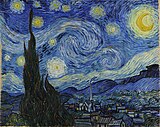Art movement
Art movement
Jump to navigation
Jump to search
 |
History of art |
|
Art history |
An art movement is a tendency or style in art with a specific common philosophy or goal, followed by a group of artists during a restricted period of time, (usually a few months, years or decades) or, at least, with the heyday of the movement defined within a number of years. Art movements were especially important in modern art, when each consecutive movement was considered as a new avant-garde.
Contents
1 Concept
2 19th-,20th- and 21st-century art movements
2.1 19th century
2.2 20th century
2.2.1 1900–1921
2.2.2 1920–1945
2.2.3 1940–1965
2.2.4 1965–2000
2.3 21st century
3 See also
4 References
5 External links
Concept[edit]
According to theories associated with modernism and the concept of postmodernism, art movements are especially important during the period of time corresponding to modern art.[1] The period of time called "modern art" is posited to have changed approximately halfway through the 20th century and art made afterward is generally called contemporary art. Postmodernism in visual art begins and functions as a parallel to late modernism[2] and refers to that period after the "modern" period called contemporary art.[3] The postmodern period began during late modernism (which is a contemporary continuation of modernism), and according to some theorists postmodernism ended in the 21st century.[4][5] During the period of time corresponding to "modern art" each consecutive movement was often considered a new avant-garde.[4]
Also during the period of time referred to as "modern art" each movement was seen corresponding to a somewhat grandiose rethinking of all that came before it, concerning the visual arts. Generally there was a commonality of visual style linking the works and artists included in an art movement. Verbal expression and explanation of movements has come from the artists themselves, sometimes in the form of an art manifesto,[6][7] and sometimes from art critics and others who may explain their understanding of the meaning of the new art then being produced.
In the visual arts, many artists, theorists, art critics, art collectors, art dealers and others mindful of the unbroken continuation of modernism and the continuation of modern art even into the contemporary era, ascribe to and welcome new philosophies of art as they appear.[8][9]Postmodernist theorists posit that the idea of art movements are no longer as applicable, or no longer as discernible, as the notion of art movements had been before the postmodern era.[10][11] There are many theorists however who doubt as to whether or not such an era was actually a fact;[4] or just a passing fad.[5][12]
The term refers to tendencies in visual art, novel ideas and architecture, and sometimes literature. In music it is more common to speak about genres and styles instead. See also cultural movement, a term with a broader connotation.
As the names of many art movements use the -ism suffix (for example cubism and futurism), they are sometimes referred to as isms.
19th-,20th- and 21st-century art movements[edit]
19th century[edit]

Jacques-Louis David, The Coronation of Napoleon, (1806), Musée du Louvre, Neoclassicism

Eugène Delacroix, Liberty Leading the People 1830, Romanticism

Thomas Cole, The Course of Empire: The Savage State 1836, Hudson River School

Gustave Courbet, Stone-Breakers, 1849, Realist School

Jean-Baptiste-Camille Corot, c. 1867, Ville d'Avray National Gallery of Art, Washington, DC, Barbizon School[13]
Claude Monet, Haystacks, (sunset), 1890–1891, Museum of Fine Arts, Boston, Impressionism

Vincent van Gogh, The Starry Night, 1889, Post-Impressionism

Edvard Munch, 1893, early example of Expressionism
.mw-parser-output div.columns-2 div.columnfloat:left;width:50%;min-width:300px.mw-parser-output div.columns-3 div.columnfloat:left;width:33.3%;min-width:200px.mw-parser-output div.columns-4 div.columnfloat:left;width:25%;min-width:150px.mw-parser-output div.columns-5 div.columnfloat:left;width:20%;min-width:120px
|
|
20th century[edit]
1900–1921[edit]

Wassily Kandinsky, 1903, Der Blaue Reiter 21.1 cm × 54.6 cm (8.3 in × 21.5 in)
Pablo Picasso, Family of Saltimbanques, 1905, Picasso's Rose Period

Henri Matisse 1905, Fauvism

Pablo Picasso 1907, Proto-Cubism

Georges Braque 1910, Analytic Cubism

Kazimir Malevich, (Supremus No. 58), Museum of Art, 1916, Suprematism

Marcel Duchamp, Fountain, 1917, photograph by Alfred Stieglitz, Dada

Albert Gleizes, Woman with Black Glove, 1920, Crystal Cubism

Piet Mondrian, Tableau I, 1921, De Stijl
|
|
1920–1945[edit]

Theo van Doesburg, Composition XX, 1920, De Stijl

Max Ernst, The Elephant Celebes (1921), Tate, Surrealism
Charles Demuth, I Saw the Figure 5 in Gold, 1928, Metropolitan Museum of Art, Precisionism

Grant Wood, American Gothic, 1930, Social Realism
|
|
1940–1965[edit]

Arshile Gorky, The Liver is the Cock's Comb (1944), oil on canvas, 731⁄4 × 98" (186 × 249 cm) Albright–Knox Art Gallery, Buffalo, New York. Gorky was an Armenian-born American painter who had a seminal influence on Abstract Expressionism. De Kooning said: "I met a lot of artists — but then I met Gorky... He had an extraordinary gift for hitting the nail on the head; remarkable. So I immediately attached myself to him and we became very good friends."[14]
|
|
1965–2000[edit]

Art & Language, Untitled Painting (1965), Tate, Conceptual art

Art & Language, Art-Language Vol.3 No.1 (1974), Château de Montsoreau-Museum of Contemporary Art, Conceptual art
Tony Smith, She Who Must Be Obeyed, 1975, Tony Smith Department of Labour Building, Minimalism

Dan Flavin, Untitled (Corner Piece), 1930, Tate Liverpool, Installation art
|
|
21st century[edit]
|
|
See also[edit]
- 20th-century Western painting
- Art periods
- List of art movements
- Post-expressionism
- Western art history
References[edit]
^ Man of his words: Pepe Karmel on Kirk Varnedoe — Passages – Critical Essay Artforum, Nov, 2003 by Pepe Karmel
^ The Originality of the Avant Garde and Other Modernist Myths Rosalind E. Krauss, Publisher: The MIT Press; Reprint edition (July 9, 1986), Part I, Modernist Myths, pp.8–171
^ The Citadel of Modernism Falls to Deconstructionists, – 1992 critical essay, The Triumph of Modernism, 2006, Hilton Kramer, pp 218–221.
^ abc Post-Modernism: The New Classicism in Art and Architecture Charles Jencks
^ ab William R. Everdell, The First Moderns: Profiles in the Origins of Twentieth-century Thought, University of Chicago Press, 1997, p4. .mw-parser-output cite.citationfont-style:inherit.mw-parser-output qquotes:"""""""'""'".mw-parser-output code.cs1-codecolor:inherit;background:inherit;border:inherit;padding:inherit.mw-parser-output .cs1-lock-free abackground:url("//upload.wikimedia.org/wikipedia/commons/thumb/6/65/Lock-green.svg/9px-Lock-green.svg.png")no-repeat;background-position:right .1em center.mw-parser-output .cs1-lock-limited a,.mw-parser-output .cs1-lock-registration abackground:url("//upload.wikimedia.org/wikipedia/commons/thumb/d/d6/Lock-gray-alt-2.svg/9px-Lock-gray-alt-2.svg.png")no-repeat;background-position:right .1em center.mw-parser-output .cs1-lock-subscription abackground:url("//upload.wikimedia.org/wikipedia/commons/thumb/a/aa/Lock-red-alt-2.svg/9px-Lock-red-alt-2.svg.png")no-repeat;background-position:right .1em center.mw-parser-output .cs1-subscription,.mw-parser-output .cs1-registrationcolor:#555.mw-parser-output .cs1-subscription span,.mw-parser-output .cs1-registration spanborder-bottom:1px dotted;cursor:help.mw-parser-output .cs1-hidden-errordisplay:none;font-size:100%.mw-parser-output .cs1-visible-errorfont-size:100%.mw-parser-output .cs1-subscription,.mw-parser-output .cs1-registration,.mw-parser-output .cs1-formatfont-size:95%.mw-parser-output .cs1-kern-left,.mw-parser-output .cs1-kern-wl-leftpadding-left:0.2em.mw-parser-output .cs1-kern-right,.mw-parser-output .cs1-kern-wl-rightpadding-right:0.2em
ISBN 0-226-22480-5
^ "Poetry of the Revolution. Marx, Manifestos, and the Avant-Gardes" introduction, Martin Puchner Retrieved April 4, 2006
^ "Looking at Artists' Manifestos, 1945–1965", Stephen B. Petersen Archived September 27, 2011, at the Wayback Machine. Retrieved April 4, 2006
^ Clement Greenberg: Modernism and Postmodernism, seventh paragraph of the essay. URL accessed on June 15, 2006
^ Clement Greenberg: Modernism and Postmodernism, William Dobell Memorial Lecture, Sydney, Australia, Oct 31, 1979, Arts 54, No.6 (February 1980). His final essay on modernism Retrieved October 26, 2011
^ Ideas About Art by Desmond, Kathleen K. [1], John Wiley & Sons, 2011, p.148
^ International postmodernism: theory and literary practice, Bertens, Hans [2], Routledge, 1997, p.236
^ Alan Kirby, The Death of Postmodernism and Beyond
^ National Gallery of Art
^ Willem de Kooning (1969) by Thomas B. Hess
External links[edit]
the-artists.org Art movements since 1900.
20th-Century Art Compiled by Dr.Witcombe, Sweet Briar College, Virginia.
WebMuseum, Paris Themes index and detailed glossary of art periods.
Categories:
- Art movements
- Art history
- Style
- Visual arts
(window.RLQ=window.RLQ||).push(function()mw.config.set("wgPageParseReport":"limitreport":"cputime":"0.392","walltime":"0.512","ppvisitednodes":"value":1303,"limit":1000000,"ppgeneratednodes":"value":0,"limit":1500000,"postexpandincludesize":"value":99980,"limit":2097152,"templateargumentsize":"value":10806,"limit":2097152,"expansiondepth":"value":13,"limit":40,"expensivefunctioncount":"value":0,"limit":500,"unstrip-depth":"value":1,"limit":20,"unstrip-size":"value":35240,"limit":5000000,"entityaccesscount":"value":0,"limit":400,"timingprofile":["100.00% 298.956 1 -total"," 29.69% 88.748 1 Template:Reflist"," 19.19% 57.374 1 Template:ISBN"," 12.10% 36.167 1 Template:Catalog_lookup_link"," 10.85% 32.445 1 Template:History_of_art_sidebar"," 10.28% 30.737 1 Template:Convert"," 10.19% 30.476 4 Template:Navbox"," 10.03% 29.972 1 Template:Sidebar"," 6.44% 19.253 6 Template:Columns"," 5.96% 17.807 1 Template:Avant-garde"],"scribunto":"limitreport-timeusage":"value":"0.047","limit":"10.000","limitreport-memusage":"value":2959461,"limit":52428800,"cachereport":"origin":"mw1322","timestamp":"20181107014123","ttl":1900800,"transientcontent":false);mw.config.set("wgBackendResponseTime":86,"wgHostname":"mw1256"););


























 Clash Royale CLAN TAG
Clash Royale CLAN TAG